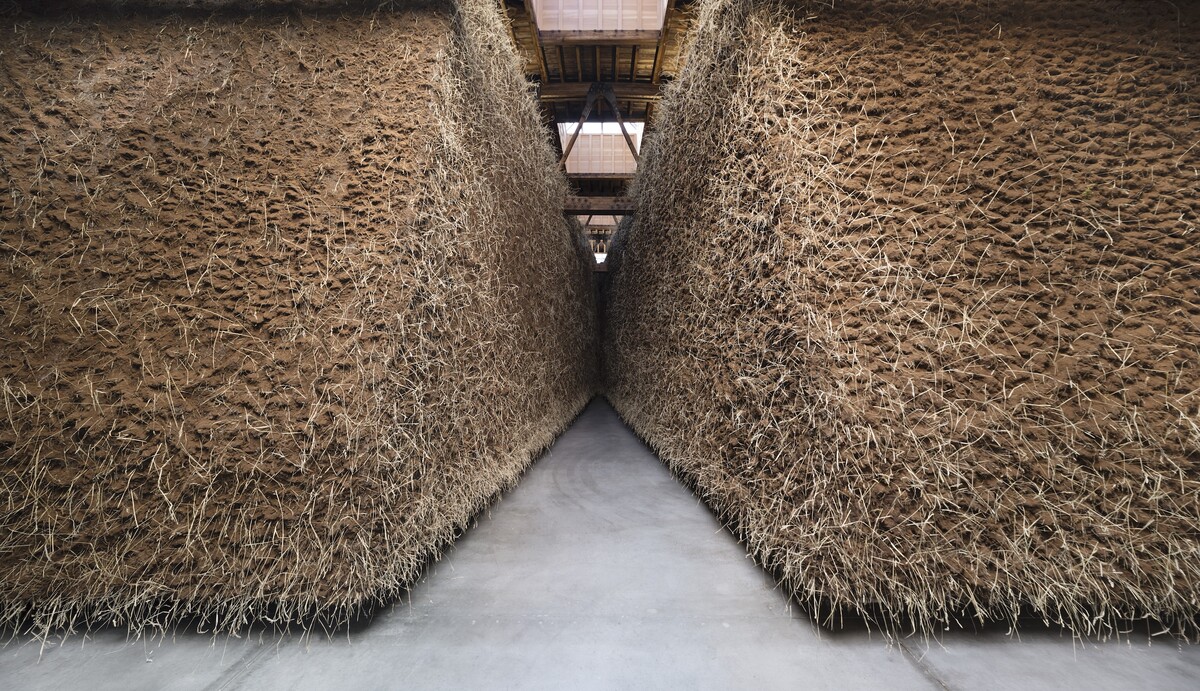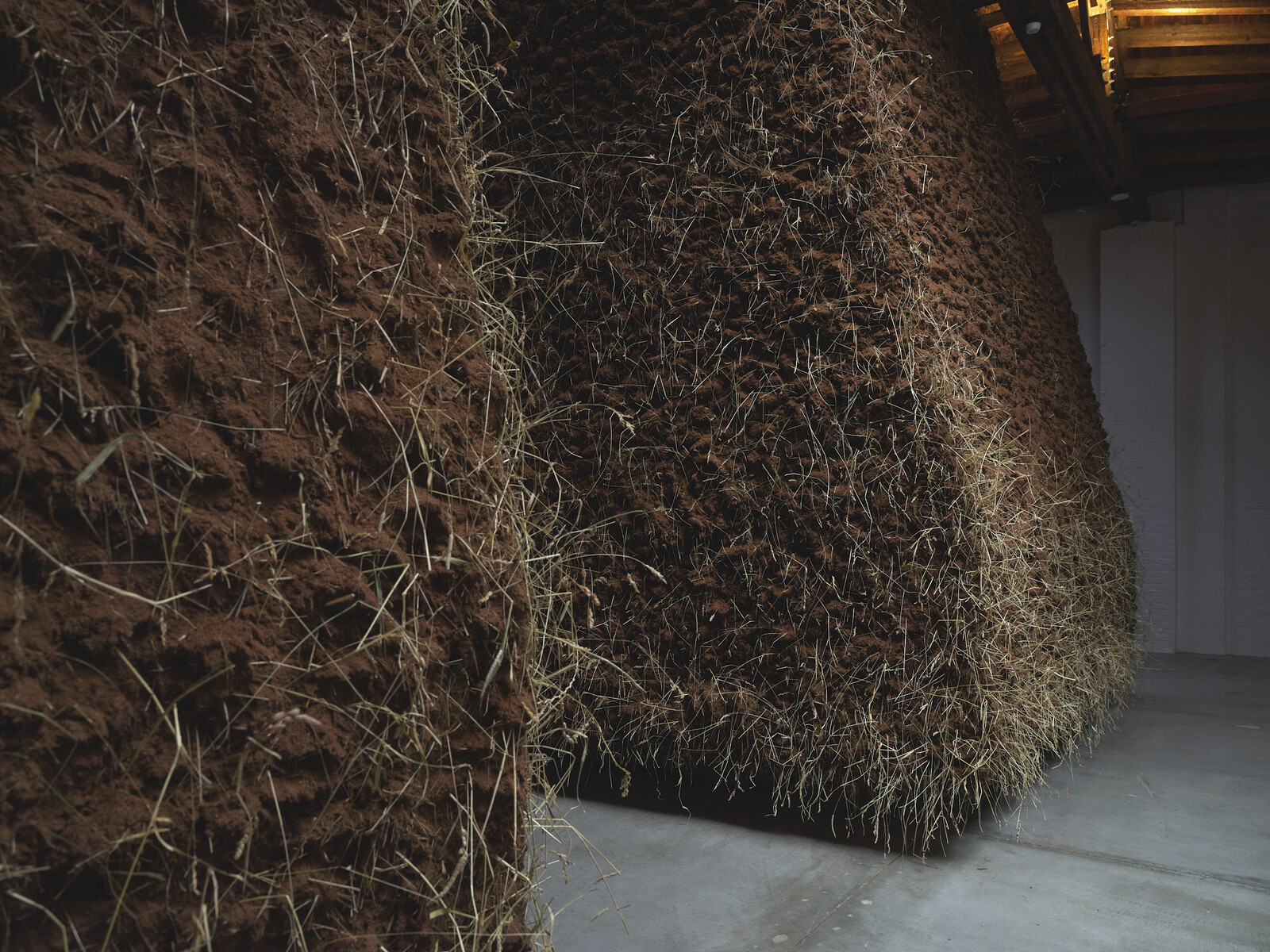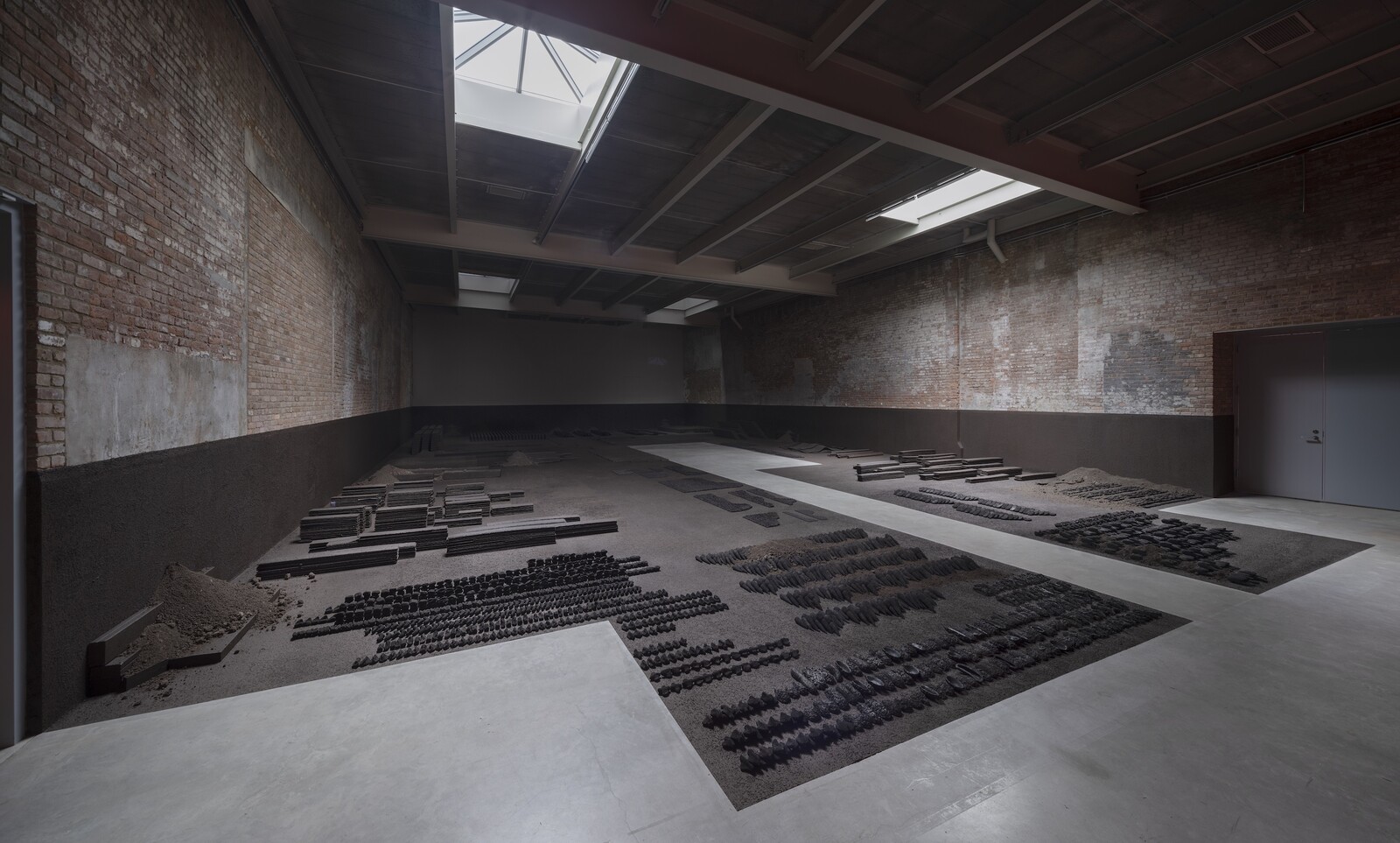Here lie the ruins of the American avant-garde. Wood salvaged from an installation by Dan Graham, offcuts from a felt piece by Robert Morris, and scraps of flooring from a Dorothea Rockburne display. Mounds of soil recall Robert Smithson’s geological samples and rows of pipe echo Walter de Maria’s Broken Kilometer (1979) of brass rods lined up on the floor. These fragments now sit in darkness, illuminated only by four shaded skylights. They are arranged across the space along with sheets of corrugated metal, parallel stacks of wooden planks, and hundreds of small pieces of Colombian pottery. Everything is dark brown and sitting on a crust of mud which rises up the walls to a high-water mark, I later read, left after the gallery flooded during Hurricane Sandy.
Despite their simple forms and materials, the objects become mirage-like in this dimly lit monochrome expanse. Walking down the pier of clean floor that stretches into the room, I try to perceive the scale and texture of the things around me, but they evade my grasp. The light fades and they retreat further. Cielo terrenal [Earthly heaven] (2023), the first of two installations by Colombian artist Delcy Morelos at Dia Chelsea, is aptly named. It is both solid and ethereal, hardware store and spirit world.
Morelos takes advantage of the setting, using materials from previous exhibitions at Dia, a major promoter of American Minimalism and Land Art, to challenge the values of these movements. The belief in monolithic conceptual progress exemplified by such work is questioned, even ridiculed, by its appearance here as assorted refuse. With its play of light and space, Cielo terrenal imbues this waste with life and so embodies a cyclicality antithetical to the iconoclastic art it cannibalizes. Out of destruction, whether by Sandy or Smithson, comes renewal. In this respect, the installation encapsulates the condition of art after the dissolution of the avant-garde: finding new potential in its remnants and formulating alternative models of artistic production in its place.
A steep montaña of earth, as Morelos calls it, fills the second room. Blades of long grass sprout, wavering in the air-conditioned breeze, and along with the barn-like wooden roof evoke a vague sense of rural tranquillity. If Cielo terrenal leaves me longing for something to cling onto, El abrazo [The Embrace] (2023) more than satisfies the craving for sensory connection. The space is filled with the smell of damp humus, and Morelos invites us to touch the dirt. (It is still under my fingernails as I write.) On one side of the structure is a deep opening that narrows to a point, inviting the viewer into the eponymous “embrace.” Voices become muffled as I enter the crevasse, and the pitch of the air con lowers like wind outside a cave. The earth closes in, enveloping my body and sealing me off from the city outside. Is that my heartbeat I can hear or the soil crawling with life?
Much Land Art is characterized by an approach to earth as inert matter to be manipulated by machinery and explosives—as fodder for conceptual experimentation rather than a living substance. Dirt invades the interior of De Maria’s New York Earth Room (1977), filling a second floor SoHo apartment, but is raked regularly to remove organic growth and preserve its crisp appearance. Such art uses horizontality and downward movement—raking, tipping, pouring—to stress the baseness of earth and the collapse of the conventional upstanding artwork, its fall from the pedestal of humanist culture. But in hindsight, this bravura approach is indicative less of aesthetic transgression than the environmental complacency of post-war America. At its worst, it typifies the colonial extractivism central to US history. Michael Heizer’s City (1970–2022), for instance, is built on settled land, appropriates forms from pre-Hispanic architecture, and was funded by an heir of the ecocidal mining conglomerate 3M.1
While these land artists used dirt to disrupt the spaces and values of art, Morelos exploits the spaces and values of art to sanctify dirt. She reinstates the pedestal, raising her montaña off the floor to prevent people kicking it. “There is no gravity,” she says, rejecting Smithson’s preoccupation with digging and tipping, “and the moment there is no gravity, earth is sacred.”2 Informed by beliefs among indigenous Amazonian and Andean peoples in the divinity of soil, El abrazo does not wallow on the ground but points to the sky. In our era of hateful ideology and environmental collapse, macho gestures of destruction no longer pass for radical action. Morelos quietly asserts hope against futile pessimism and the power of earth against its exploitation.
Jasmine Liu, “What Do Native Artists Think of Michael Heizer’s New Land Art Work?,” Hyperallergic (September 21, 2022), https://hyperallergic.com/763203/what-do-native-artists-think-of-michael-heizers-new-land-art-work/.
“Delcy Morelos in Conversation with Alexis Lowry and Zuna Maza,” Dia Art Foundation (October 5, 2023), https://www.youtube.com/watch?v=t9NOJwIpcN4.





